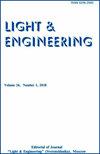紫外二极管在水消毒中的应用效果研究
IF 0.3
4区 工程技术
Q4 ENGINEERING, ELECTRICAL & ELECTRONIC
引用次数: 0
摘要
本文讨论了紫外发光二极管在流体介质消毒中的合理应用问题。介绍了现代UV led的主要优点和缺点,并对其发展和应用前景进行了展望。低能量效率是主要的故障之一,这大大限制了使用半导体器件的可能性。为了评估能量的效率,建立了基于UV led的辐射系统的热学模型。该系统提供类似于DB75型气体放电灯的辐射能量流。该系统运行的模拟与被动和主动冷却应用于紫外发光二极管。主动冷却系统是由热电模块实现的。对主动冷却系统各参数下的热过程进行了计算。已经确定了冷却系统的最佳参数,从而提供了最有利的UV led操作热模式。由于应用了主动冷却,可以将系统的重量和尺寸指标降低12%。与此同时,它的能耗显著增加,这进一步降低了能源效率。根据已开发的具有被动和主动冷却的辐照系统模型,根据家庭每小时耗水量和市民的饮水需求的一般时间表,计算了辐照系统的每日能源消耗。计算结果表明,即使采用被动冷却,系统日耗电量也比DB75气体放电灯多出数倍。它证实,由于其低能效,目前在使用UV led对液体介质进行消毒方面存在重大限制。但需要注意的是,UV led的生产技术是动态发展的。这一事实使我们能够乐观地说,在未来的消毒系统中应用半导体器件的可能性。本文章由计算机程序翻译,如有差异,请以英文原文为准。
About Efficiency of the Ultraviolet Diodes Applied for Disinfection of Water
The article discusses the question of reasonable application of UV LEDs for disinfection of the fluid mediums. There are the main advantages and failures of modern UV LEDs as well as the perspectives for their development and application presented. The low energy efficiency is noted among the main failures that significantly limit the possibility to use the semiconductor devices. In order to evaluate the efficiency of energy, the thermal model of the radiation system based on UV LEDs has been created. This system provides the energy flow of radiation similar to the flow of the gas discharge lamp of DB75 type. The simulation of this system operation is performed with the passive and active cooling applied to UV emitting diodes. The active cooling system is implemented by the thermoelectric modules used. There is calculation of the thermal processes at various parameters of the active cooling system carried out. Optimal parameters of the cooling system have been determined, at which the most favourable thermal mode of operation of UV LEDs is provided. Due to the active cooling applied it was possible to reduce the weight and size indicators of the system by 12 %. And at the same time its energy consumption increased significantly, that allowed additionally to decrease the energy efficiency. Basing on the developed models of the irradiation system with passive and active cooling there was the calculation of its daily energy consumption performed in accordance with a generic schedule of the water consumption per hour for the household and drinking needs of citizens. The results of calculation showed that if to use even the passive cooling, the system consumes the several times more electricity per day compared to the DB75 gas discharge lamp. It confirms that there are currently significant restrictions on the use of UV LEDs for disinfection of liquid media due to their low energy efficiency. But it should be noted that the technology of UV LEDs production is progressing dynamically. This fact allows us to say with optimism about the possibility to apply the semiconductor devices in systems of disinfection in the future.
求助全文
通过发布文献求助,成功后即可免费获取论文全文。
去求助
来源期刊

Light & Engineering
ENGINEERING, ELECTRICAL & ELECTRONIC-OPTICS
CiteScore
1.00
自引率
50.00%
发文量
0
审稿时长
1 months
期刊介绍:
Our magazine
develops comprehensive communication within the lighting community, providing opportunities for discussion and free expression of opinions of specialists of different profiles;
contributes to the convergence of science and engineering practice, the search for opportunities for the application of research results in lighting and technological applications of light;
keeps the scientific community up to date with the latest advances in the theory of the light field, providing readers with operational professional information;
initiates international cooperation, promotes and distributes the results of Russian authors in the international professional community;
provides equal opportunities for authors from different regions of Russia and other countries.
The journal publishes articles in the following areas:
visual and non-visual effects of radiation on humans;
light field theory;
photometry and colorimetry;
sources of light;
ballasts;
light devices, their design and production technology;
lighting and irradiation installation;
light signaling;
methods of mathematical modeling of light devices and installations;
problems of energy saving in lighting, installation and operation of lighting installations;
modern production technologies of lighting products for lighting control systems;
innovative design solutions;
innovations in lighting and lighting design;
the study of the effect on plants and animals, problems of using light in medicine;
problems of disinfection of premises, water and smell elimination with the help of technology of UV radiation using;
problems of light in the ocean and space.
 求助内容:
求助内容: 应助结果提醒方式:
应助结果提醒方式:


